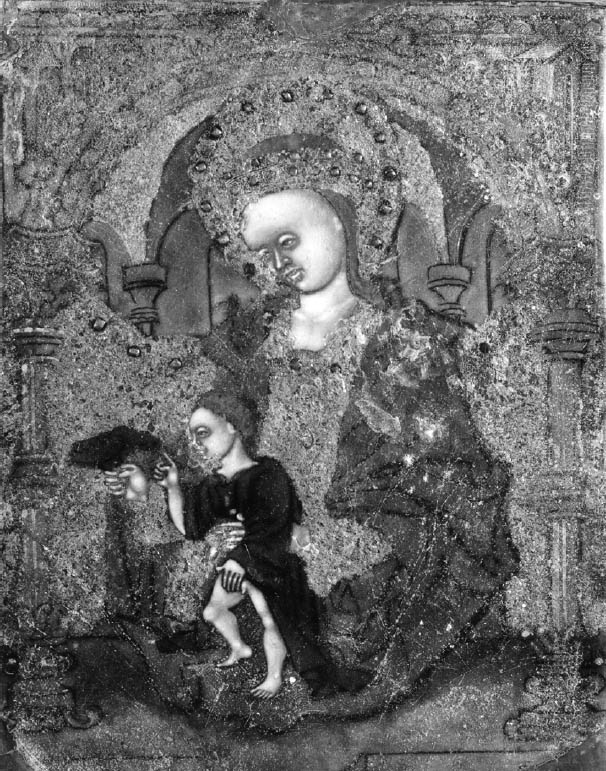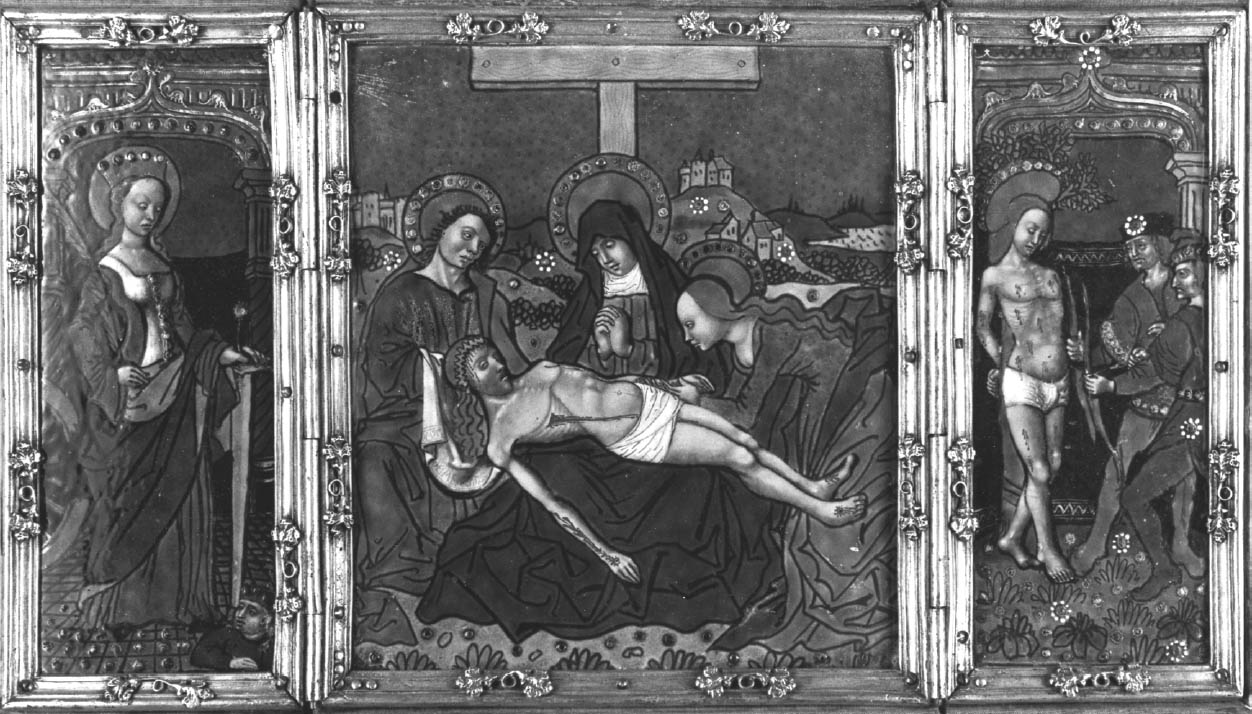THE EARLY PAINTED ENAMELS OF LIMOGES IN THE WALTERS ART MUSEUM: HISTORICAL CONTEXT AND OBSERVATIONS ON PAST TREATMENTSTERRY DRAYMAN-WEISSER
4 THE WALTERS COLLECTION OF EARLY PAINTED LIMOGES ENAMELSAccording to Philippe Verdier in his catalogue of the painted enamels of the Renaissance in the Walters Art Gallery, “From the 1830s and 1840s, no French art collector in the field of European decorative arts considered his collection complete without including masterpieces of the Limoges enamellers” (1967, ix). These enamels were also highly sought after by the English. Until World War I these enamels brought very high prices on the art market. Verdier continues: “Limoges enamels were looked upon by connoisseurs as supreme embodiments of form and color and as perfect fusions of draughtsmanship and the art of the goldsmith” (1967, ix). According to Verdier, the collection of painted Limoges enamels in the Walters:
Of the 201 painted Limoges enamels in the Walters collection cataloged by Verdier, 25 were identified as being made between 1470 and 1530, the dates recognized as the beginning and end of the early painted Limoges enamel period. Most of the enamels were acquired by Henry Walters in the early 20th century through various dealers. If Verdier is correct about the values placed on these enamels up to World War I, Henry Walters bought at the peak of the market. His collection today continues to amaze and delight the public and scholars, as many of the enamels retain their jewel-like character. For this reason it is especially important to inhibit further deterioration of the collection for the enjoyment of future generations. 4.1 HISTORY OF DETERIORATION AND TREATMENTIn the 1960s Peter Michaels, a painting conservator at the Walters, noted that the early painted Limoges enamels in the collection had deteriorated and showed evidence of cracking, spalling surfaces, and white salt efflorescence. The salts were identified by x-ray diffraction analysis and found to be sodium formate. As mentioned above, the source of the sodium was the alkali leaching from the enamel, and the formate was thought to be from contaminants in the environment. Another possible source of the formic acid not mentioned by Michaels was offgassing from the oak frames used to remount many of the enamels in modern times. Michaels began a treatment campaign to stabilize the actively deteriorating enamels. According to the records in the files, the premise for his treatments was to remove the salts and to consolidate the surfaces of the enamels to improve their appearance and to prevent further loss of detached flakes. The early treatment records indicate that many of the unstable enamels Michaels was to treat had been powdery and deteriorated in 1940 and had been coated at that time with Vinylite, an early polyvinyl acetate resin. (The records do not indicate what molecular weight Vinylite was used.) This previous attempt to stabilize the enamels had been unsuccessful, and in 1960 the enamels were in an even more advanced state of deterioration. Michaels's treatments began with cleaning the enamels to remove the decomposing Vinylite coating. He was not consistent in his choice of solvents for this task and seems to have used singly and in combination alcohol, water, benzine, acetone, and toluene. A variety of solvents was used because he found the Vinylite and other coatings that were not identified to be difficult to remove. Similar problems of coating removal on enamel have recently been noted by Magee (1999) after attempts to remove polyvinyl acetate (AYAA) from a crizzling enamel tazza in the collection of the Art Institute of Chicago. Besides using solvents to remove the coating, Michaels used water to dissolve salts, and alcohol and acetone to dry the enamels before applying a new coating. His records do not always state what type of alcohol or whether the water he used was distilled or from the tap. Although some treatments indicate that he swabbed the surfaces with water, others are not clear. Two treatments carried out in 1963 specifically mention immersing the enamels in acetone, then water, then alcohol. Michaels's treatments, as well as other treatments carried out on this group of enamels, are summarized in appendix 1.
Michaels (1968) described his treatment of enamel 44.126 (Virgin and Child with Parrot) (figs. 16, 17). He indicated that he submerged the enamel in water to remove the soluble alkaline salts, did a final rinse in distilled water, and put the plaque through two changes of ethyl alcohol, and finally acetone, to remove all of the water. After a thorough airing, he coated the surface heavily with AW2 (a ketone resin, polycyclohexanone) in benzine. It is not clear from the in-house records that Michaels did, in fact, submerge that particular plaque. According to documents in the files, the enamel was cleaned with alcohol and water, then acetone, and was rinsed in acetone, then methyl alcohol, then acetone. Michaels
Michaels selected AW2 resin for coating even though he did not consider it a superior moisture barrier. He felt it was readily soluble and that it would penetrate well into the flaking surfaces. He surmised that the thickness of the coating would compensate for its lower resistance to moisture and felt that the sheen of the resin approximated that of the enamel (1968). Although Magee reports (1999) that the AW2 resin on the Walters enamels has become insoluble, this statement is incorrect and likely the result of a misunderstanding. The resin remains soluble, but sometimes requires the use of more polar solvents and longer exposure to solvents for removal. These observations are supported by solubility tests carried out by Feller and Curran (1975) on aged ketone resin films. In 1970 an enamel triptych (44.316) (fig. 18) that had been treated by Michaels 10 years earlier was brought to the conservation laboratory. The central panel was an image of the Annunciation, and each wing was a prophet. The enamel was attributed to the Master of the Orl�ans Triptych. The history of the treatment of this enamel was unclear before Michaels's treatment. A 1936 photograph showed deterioration in the blue areas, but no treatment had been recorded. In 1953 there is some indication that it was coated with Vinylite. In 1960, when it was examined by Michaels, almost all of the blue was crazed and deteriorated (fig. 19). The surface was powdery, and there were small, detached chips. There was a white powdery substance on the blue surfaces, and copper salts from the plate were pushing off the enamel. Michaels treated the enamel by removing the corrosion mechanically and with acetone, alcohol, and benzine. He found a film on the surface, but determined that it did not dissolve in toluene, acetone, or alcohol. He removed this film with alcohol
An examination of this enamel in 1970 showed that there was new green corrosion on the reverse from the interaction of the copper with the alkaline products forming on the enamel. It was also evident that the crizzling had continued. At this time the author was assigned the treatment of the object. First the green corrosion products were removed mechanically. Next the AW2 resin was removed in baths of Stoddard solvent, benzine, then Stoddard solvent and xylene. Based on Michaels's treatment as represented in his 1968 article, as well as advice from Elisabeth Packard, then director of the Walters Conservation Laboratory, the enamel was immersed in four successive 20-minute baths of distilled water to remove the salts. It was then immersed in five successive baths of acetone at 10-minute intervals to remove the water. After airing overnight, the enamel was warmed slightly in a case with heat from a light bulb to drive off any excess moisture. Finally, the surface of the enamel was sprayed with six coats of 36% AW2 resin in Stoddard solvent, allowing it to dry and warming slightly between coats. The translucency was restored to the enamel, and it has not changed since that time (fig. 20). Another treatment was carried out by the author on an enamel plaque (44.645B) in 1972. The enamel had not been treated by Michaels, but microscopic examination revealed a coating that seemed similar in appearance to other Vinylite coatings. The enamel was flaking severely in the blue and amber areas. The coating was tested for solubility and found to be difficult to remove. Acetone appeared to work the best, but it did not remove the coating completely, and residues of the resin remained in the cracks. The enamel was then warmed slightly in a case with heat from a light bulb, and finally sprayed with three coats of 36% AW2 resin in Stoddard solvent. Two enamels also were coated with Paraloid B-72 (formerly Acryloid B-72: ethylmethacrylate
4.2 EVALUATION OF PAST TREATMENTSForty years have elapsed since Michaels's treatments were carried out, and 30 years since the retreatment of enamels by the author. Although a lack of detail in the records makes evaluation imprecise, visual examination through a microscope can give some sense of the success of the previous treatments. Since the treatment of unstable Limoges enamels is still a challenge for the conservator, any information one can glean about the long-term behavior of materials and treatment regimens used with these objects is of value. Appendix 1 summarizes the treatment history of each enamel based on the conservation records. To prevent inadvertent changes in meaning, descriptions of condition and treatment in appendix 1 have been reported as in the original, and no attempt has been made to make the vocabulary consistent. The column on the far right in appendix 1 indicates the current condition of the enamel evaluated with a binocular microscope at 25x. For the purposes of this study, an enamel was considered unstable if any area, no matter how small, was found to be weeping or disrupted by crizzling. Three categories of crizzling were established based on the level of activity. These were identified in the table as minor A review of the results of Michaels's treatments may initially indicate a lack of success. Most of the enamels have exhibited some degree of ongoing or current deterioration. However, in every case, the condition is considerably better than it was before Michaels's treatments in 1960. In fact, the new activity is generally localized and in many cases difficult to see without the aid of magnification. A comparison of photographs of before and after treatment in 1960 and today's condition makes this point clear (figs. 21–27). One enamel that was treated but initially does not seem improved is 44.128. This plaque was cleaned and coated in 1961. Then in 1963, after removing the coating, it was soaked in water, but not recoated. The surface is currently crizzling overall and is efflorescing with white salts. However, if one compares its current condition with its condition in photographs taken before treatment in 1960 and during treatment in 1961, it is not clear that its condition has worsened. It appears that the enamel is in better condition than before treatment in 1960, and in similar condition to that in 1961 after cleaning but before coating. Of interest is the fact that no new deterioration is evident on enamel 44.316, which had had a history of recurring deterioration and had been re-treated by the author in 1970 (fig. 28, see page 255). During retreatment this enamel was more thoroughly soaked in distilled water than the others, and it is likely that the soluble elements of the glass, usually involved in the deterioration process, were removed from deeper within the enamel layer. This procedure may have left the upper layer of the glass less reactive with the environment. Since the enamel was heated slightly during drying, excess moisture was driven off just before coating. This step allowed the resin to flow more readily into the cracks, creating a better barrier than
The enamel (44.645B) treated by the author in 1972 also has remained stable. This enamel was not soaked in water, but was warmed before three spray coats of AW2 resin were applied. Therefore, this finding may support the possibility that warming and/or thickness of the coating plays a significant role in preservation. The enamels coated with Paraloid B-72 have not remained stable. Since only one coat of a relatively dilute solution of Paraloid B-72 was applied, more study should be carried out applying thicker or more concentrated coatings of this resin. A comparison of the current condition of the treated enamels to two enamels that have never been treated (44.438 and 44.136) is compelling and informative (figs. 29, 30; see also figs. 2, 3, and 5). The untreated enamels are in far worse condition than all of the treated enamels. A comparison of photographs taken in 1977 and 2002 showing details of the collar on a figure in untreated enamel 44.438 documents a significant progression of disruption and loss (figs. 31, 32, see page 256). Generally there is severe crizzling on the untreated enamels with total detachment of flakes from the surface. The blue and mulberry enamels on 44.438 have been observed on many occasions cycling between crizzling and weeping (see fig. 3, page 252). The enamel on this piece is being pushed from the substrate by corrosion caused by a reaction of the copper plate with the alkaline liquid that forms during weeping. It is clear that the untreated enamels have suffered more surface loss and are currently more active than the enamels that have been treated. 4.3 OBSERVATIONSThe following observations can be made after reviewing the treatment records, photographic documentation, and current condition of 25 early painted Limoges enamels in the Walters collection:
Although it is tempting to conclude from these observations that washing, drying, warming, and thickly coating the actively deteriorating painted enamels is a satisfactory treatment, it must be kept in mind that there are many risks involved. Washing with water can remove salts, but it also can alter the chemical makeup of the enamel. In this instance such alteration may have its long-term advantages for stability; however, the introduction of water to the enamel can also encourage further hydration of the enamel surface and activation of corrosion of the copper plate. Immersing the enamel in solvents such as ethanol and acetone to dry them can cause shrinkage of the hydrated layer and encourage crizzling and cracking. Also, the lowering of the temperature of the enamel with acetone can cause condensation to occur immediately after drying, again introducing water into the enamel. Warming the enamel is generally not advisable, as crizzling can be encouraged during drying. Coating enamels can have positive and negative aspects. Coatings may give some protection from atmospheric moisture and can secure flaking surfaces and restore translucency by filling in cracks. As has been demonstrated, however, a coating can cause problems as well. While the AW2 resin used on the Walters enamels remains soluble, has not visibly yellowed, and has held up well over time, the Vinylite resin broke down and became significantly less soluble relatively quickly. Deterioration continued beneath the Vinylite, and enamel spalled away with the detaching coating. When the same enamels were later coated with AW2 resin, they underwent significantly less damage, even when crizzling recurred. It is possible that the AW2 resin performed better due to a combination of factors. The resin's ability to penetrate tiny cracks in the enamel surfaces easily and the fact that the resin was applied in a thick layer may have inhibited the interaction of the enamel with the
4.4 THE FUTURE OF EARLY PAINTED LIMOGES ENAMELSOne must weigh all the potential risks discussed above, but while waiting for the development of a treatment or environment that will preserve the enamels, active deterioration inevitably proceeds. For those who must care for early painted enamels from Limoges, this dilemma is especially profound. The evaluation of the current condition of the Walters collection of early painted Limoges enamels can give us some basis for future directions in approaching the preservation of these objects. The inherent instability of these objects is a major challenge, and much still needs to be done even to determine the best environment for their storage and display. Analysis of the enamels currently being carried out by French, German, and American scientists may lead to a better understanding of the causes of deterioration and how treatments may impact the enamels themselves. The results of these studies were reported at the International Symposium on Limoges Painted Enamels held in 2002 in Braunschweig, Germany, and should be published in the future. The treatments carried out at the Walters, even though successful to varying degrees, need further study, and other treatments need to be developed and evaluated. There is some promise for at least a better understanding of the mechanisms involved in the deterioration processes and long-term evaluation of possible treatments and coatings. Discussions have recently taken place among scientists and several conservators in institutions with collections of unstable enamels. It is through such collaboration that the early painted enamels of Limoges finally may be saved. ACKNOWLEDGEMENTSI wish to thank my colleagues at the Walters for their support and forbearance as I covered every surface in the laboratory with Limoges enamels and monopolized microscope and cameras on many occasions. I am especially indebted to Meg Craft, Julie Lauffenburger, and Robert Weisser, who willingly and with the best of humor read too many drafts of this article. They are responsible for many improvements to the text. I also wish to thank Dawn Brown, who converted my nearly illegible notes into appendix 1. |











